Decision trees are powerful tools used in machine learning and data analysis to make informed decisions based on input data. They are versatile, intuitive, and widely employed in various fields such as finance, healthcare, and marketing. In this article, we will explore the concept of decision trees, the templates, and their applications.
Part 1. Introduction to Decision Trees
Decision trees are visual representations of possible outcomes and the choices that lead to them. They are a powerful tool for organizing complex information and aiding in the decision-making process. In both business and personal life, decision trees help clarify the path to the desired outcome by breaking down a problem into manageable parts.
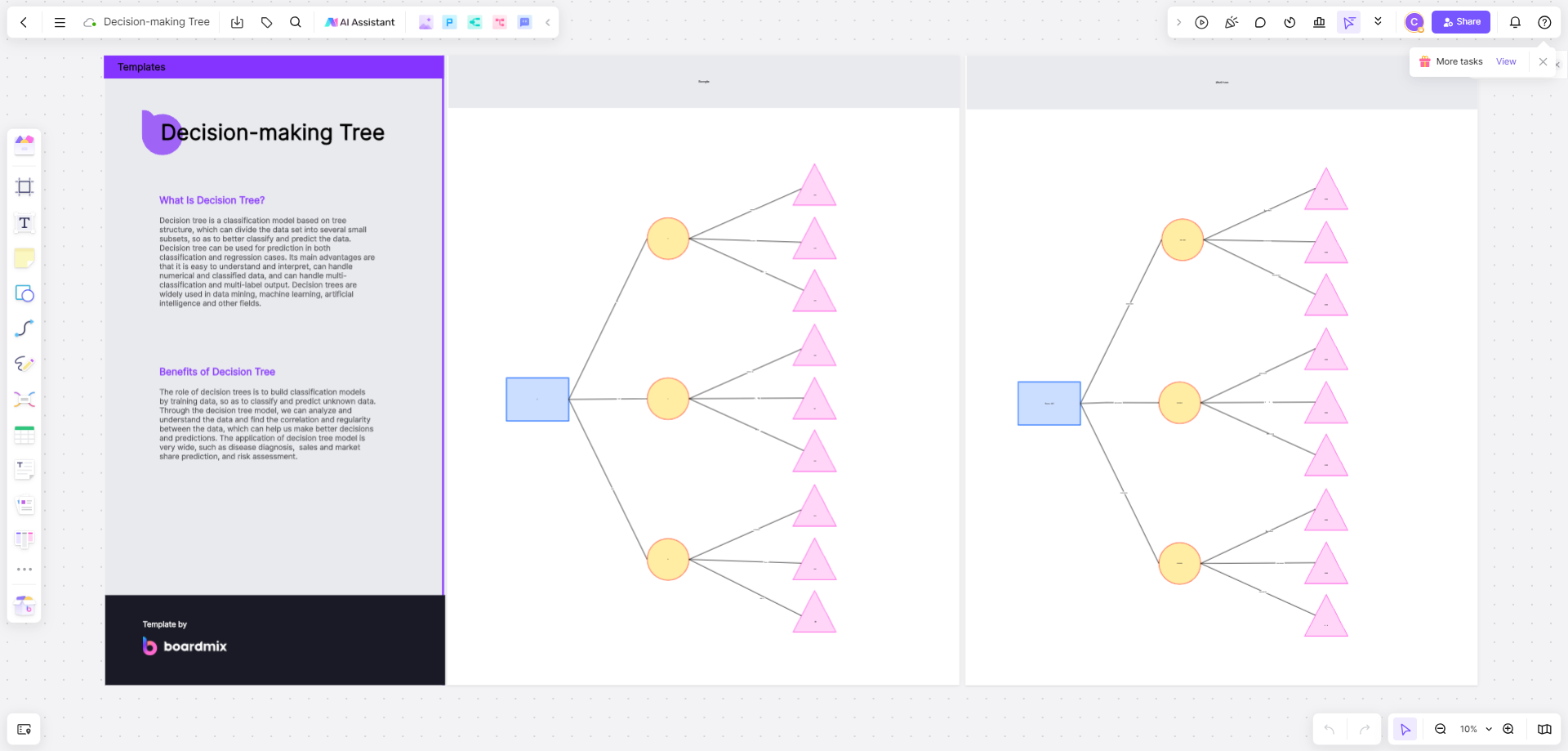
Importance of Decision Trees in Business and Personal Life
In business, decision trees are used for strategic planning, risk assessment, and problem-solving. They help managers and executives weigh the pros and cons of different options, anticipate potential risks, and make informed decisions. In personal life, decision trees can assist with major life choices, such as career paths, education, and financial investments.
To effectively use decision trees, it's essential to understand their basic components and types.
Components of a Decision Tree
- Decision Nodes: These represent points where a choice must be made. They are typically depicted as squares or rectangles.
- Chance Nodes: These nodes indicate outcomes that are influenced by chance or external factors. They are often shown as circles.
- Terminal Nodes: These are the end points of the tree, representing the outcomes or results. They are usually depicted as triangles or simple dots.
Types of Decision Trees
- Binary Trees: These trees have two branches at each decision node, representing a yes/no or true/false choice.
- Multi-Branch Trees: These trees allow for more than two branches at each decision node, accommodating more complex scenarios.
- Hierarchical Trees: These trees are organized in a strict hierarchy, with each level representing a different stage in the decision-making process.
Part 2. Benefits of Using Online Decision Tree Templates
Online decision tree templates offer several advantages, making them an attractive option for many users.
- Time Efficiency: Creating a decision tree from scratch can be time-consuming. Online templates provide a pre-designed structure that can be quickly customized to fit specific needs, saving valuable time.
- Cost-Effectiveness: High-quality decision tree templates are often available for free, making them an affordable solution for individuals and small businesses.
- Customizability and Flexibility: Online templates allow users to add, remove, or modify branches, nodes, and other elements to create a decision tree that perfectly fits their unique situation.
- Ease of Sharing and Collaboration: Online tools enable easy sharing of decision trees with colleagues or stakeholders, facilitating collaboration and feedback.
Part 3. Real-Life Applications of Decision Trees
Decision trees have been used in a variety of contexts, from business strategy to personal life decisions.
Decision Tree for Marketing Campaign Strategy
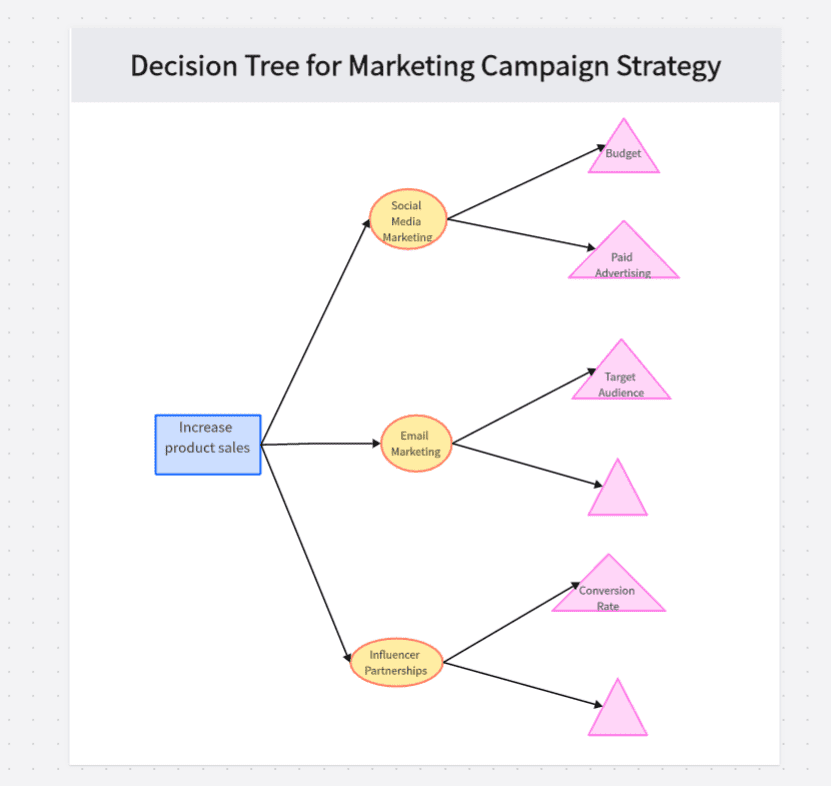
Objective: Determine the best marketing strategy to increase product sales.
Steps:
-
Define the Decision Problem:
- Question: Which marketing strategy should we implement to boost product sales?
-
Identify Decision Options:
- Options:
- Social Media Marketing
- Email Marketing
- Influencer Partnerships
- Paid Advertising
- Options:
-
Determine Key Factors:
- Factors:
- Budget
- Target Audience
- Expected Reach
- Conversion Rate
- Factors:
-
Construct the Decision Tree:
- Evaluate and Select:
- Review the outcomes and choose the strategy with the best potential return on investment.
Application: Used by marketing managers to plan and execute effective marketing strategies based on budget and audience analysis.
Decision Tree for IT Troubleshooting
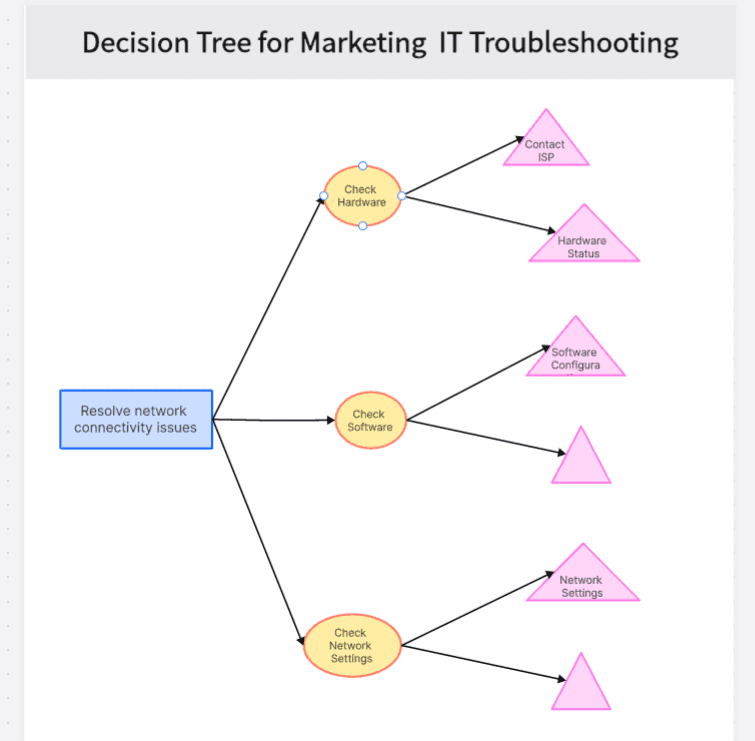
Objective: Resolve network connectivity issues efficiently.
Steps:
-
Define the Decision Problem:
- Question: What steps should be taken to troubleshoot and fix the network connectivity issue?
-
Identify Decision Options:
- Options:
- Check Hardware
- Check Software
- Check Network Settings
- Contact ISP
- Options:
-
Determine Key Factors:
- Factors:
- Hardware Status
- Software Configuration
- Network Settings
- ISP Status
- Factors:
-
Construct the Decision Tree:
- Evaluate and Select:
- Follow the steps and resolve the issue based on the decision path.
Application: Used by IT support teams to systematically troubleshoot and resolve network issues.
Decision Tree for Personal Finance Management

Objective: Make informed financial decisions to manage personal savings and investments.
Steps:
-
Define the Decision Problem:
- Question: How should I allocate my monthly savings for optimal financial growth?
-
Identify Decision Options:
- Options:
- Savings Account
- Stocks
- Bonds
- Real Estate
- Options:
-
Determine Key Factors:
- Factors:
- Risk Tolerance
- Time Horizon
- Expected Return
- Liquidity Needs
- Factors:
-
Construct the Decision Tree:
- Evaluate and Select:
- Analyze the outcomes and choose the best investment option based on personal financial goals.
Application: Utilized by individuals to make strategic decisions regarding their savings and investment plans for financial stability and growth.
Part 4. Top Free Online Decision Tree Tools and Platforms
Top Free Online Decision Tree Tools
Some numerous online tools and platforms offer free decision tree templates. There are several free online decision tree tools available that you can use to create decision trees.
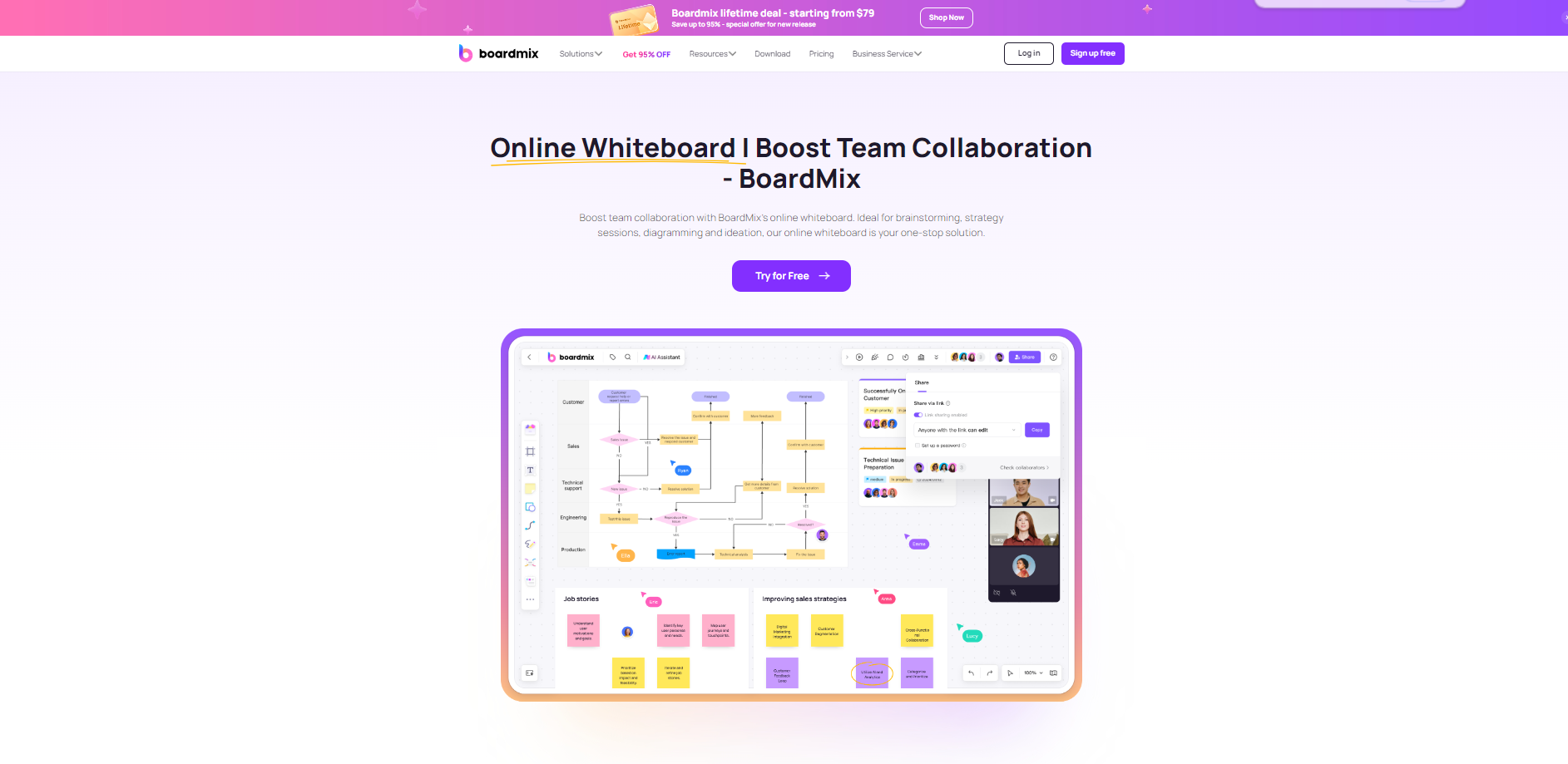
Boardmix
Boardmix offers a user-friendly interface and a variety of templates, including a decision tree template. It allows you to easily create, customize, and share decision trees.
Lucidchart
Lucidchart is a popular diagramming tool that also offers decision tree templates. It provides a drag-and-drop interface and collaboration features, making it easy to create and share decision trees.
SmartDraw
SmartDraw is another diagramming tool that allows you to create decision trees. It offers various templates and customization options, making it suitable for both beginners and advanced users.
Gliffy
Gliffy is an online diagramming tool that includes decision tree templates. It has a simple and intuitive interface, making it easy to create and edit decision trees.
Draw.io
Draw.io is a free diagramming tool that offers decision tree templates. It provides a wide range of customization options and allows you to save your decision trees in various formats.
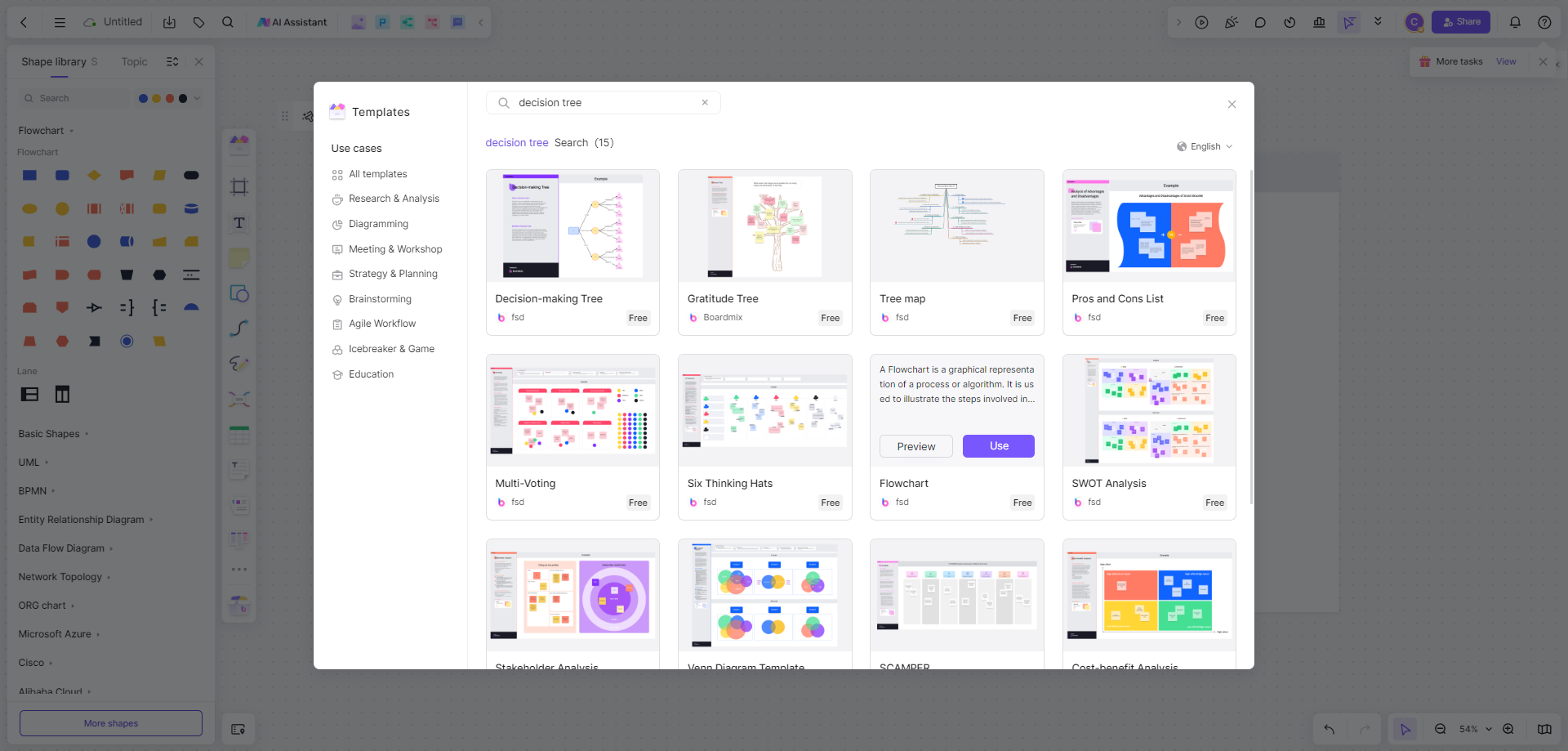
These tools often include drag-and-drop functionality, collaboration features, and the ability to link decision trees with other documents or websites. The best online decision tree tools have user-friendly interfaces that make them accessible to users of all skill levels. They also often have mobile apps, allowing users to work on their decision trees on the go.
Step-by-Step Guide to Creating a Decision Tree
Creating a decision tree using an online template is a straightforward process. Follow these step-by-step instructions to create your decision tree in Boardmix.
1. Log in to your Boardmix account and navigate to the templates section. Search for the decision tree template in the Template library and click on it to open it.
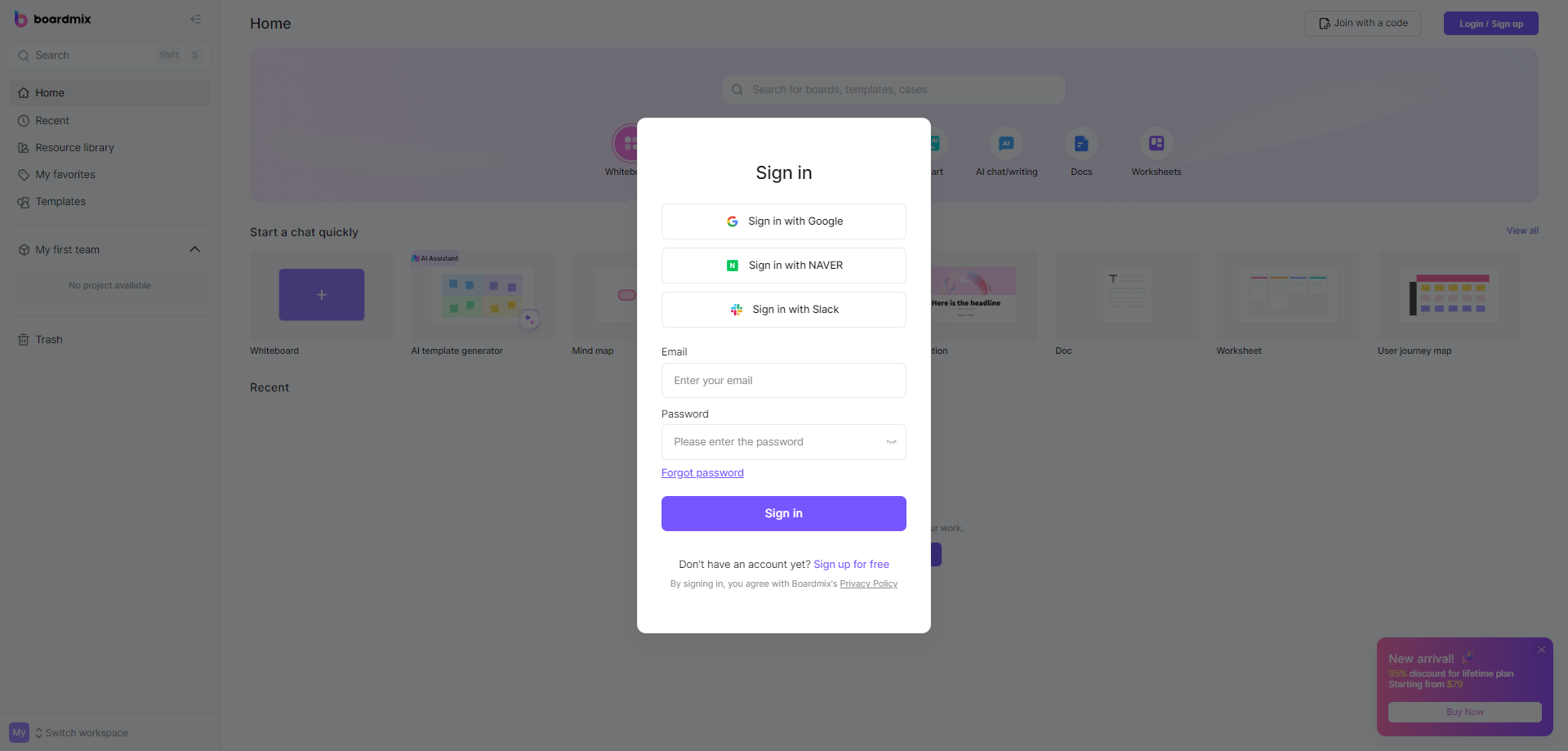
2. Customize the template according to your specific needs. You can add or remove nodes, modify labels, and include relevant information for each decision point. Start by adding the initial decision or question at the top of the tree. This will serve as the starting point for your analysis.

3. Identify the possible outcomes or choices that result from the initial decision. Add branches or nodes below the initial decision to represent these choices. For each choice, consider the potential consequences or further decisions that may arise. Add branches or nodes below each choice to represent these consequences.

4. Continue adding branches and nodes to represent all possible paths and decisions within your decision tree. Use labels and colors to differentiate between different types of nodes or branches. This can help to visually organize and highlight important information within the decision tree.
5. Once you have completed the decision tree, review and double-check all the information and connections. Make sure everything is accurately represented and logical. Then you can save and share your decision tree with others involved in the decision-making process. You can also export it as a PDF or image for easy distribution.
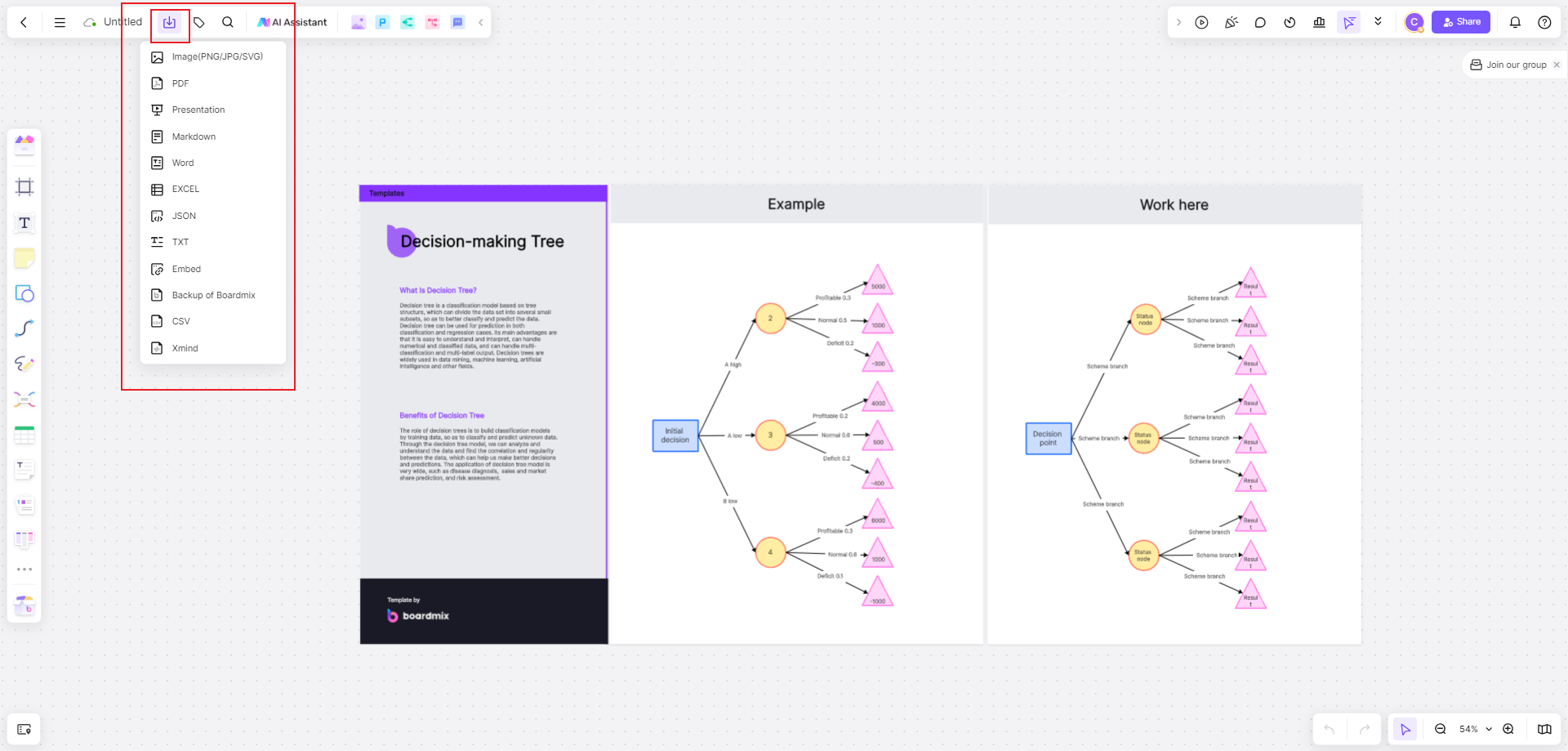
Remember, a decision tree is a powerful tool for analyzing complex decisions and understanding the potential outcomes of different choices. By using the decision tree template in Boardmix, you can visually map out your decision-making process and make more informed decisions.
Tips for Effective Decision Tree Design
- Keep it simple: Avoid overcomplicating your tree with too many branches or details.
- Use clear language: Ensure that each node and outcome is clearly labeled and easy to understand.
- Consider probabilities: If applicable, include the likelihood of each outcome occurring.
Part 5. Features of Online Decision Tree Tool Boardmix
Online decision tree tools offer several features that make them valuable for decision-making processes. Here are some of the key features of online decision tree tools Boardmix.
- User-friendly interface: The online decision tree tool Boardmix has a user-friendly interface that allows users to easily create, edit, and navigate decision trees. They often provide drag-and-drop functionality, making it easy to add nodes, branches, and outcomes.
- Collaboration capabilities: The online decision tree tool Boardmix allows team members to collaborate. This means multiple users can work on the same decision tree simultaneously, making it easier to gather input and make decisions as a team.
- Customizable templates: The decision tree tool Boardmix provides customizable templates that users can start with. These templates can be tailored to specific industries, use cases, or decision types, saving time and effort in creating a decision tree from scratch.
- Logic and branching options: The decision tree tool offers various logic and branching options to help users create complex decision trees. They allow for conditional statements, multiple outcomes, and different paths based on user inputs, enabling users to simulate various scenarios and analyze potential outcomes.
- Data analysis and visualization: The online decision tree tool Boardmix provides data analysis and visualization features. They can generate charts, graphs, and reports based on the data inputted into the decision tree, helping users better understand the potential outcomes and implications of their decisions.
- Integration with other tools: The online decision tree tool Boardmix offers integration with other software or platforms. This allows for seamless data exchange between different systems and enables users to leverage additional functionalities, such as importing data from spreadsheets or exporting decision tree results to project management tools.
Overall, the online decision tree tool Boardmix provides a convenient and efficient way to create, analyze, and visualize decision trees. They empower individuals and teams to make informed decisions by considering various factors, scenarios, and outcomes.
Part 6. Conclusion and Future of Decision Trees
Decision trees are a versatile and valuable tool for decision-making. With the rise of online templates, they are more accessible than ever, allowing individuals and organizations to make informed decisions with greater confidence. As technology continues to evolve, we can expect decision tree tools to become even more sophisticated, offering advanced features and deeper insights into complex decision-making processes.

Decision tree tools like Boardmix can help you visually represent your decision-making process and analyze complex decisions more effectively. Whether you're a business leader looking to optimize your strategy or an individual facing a tough personal choice, free online decision tree templates offer a powerful and user-friendly way to clarify your options and make the best possible decision.








